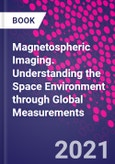Magnetospheric Imaging: Understanding the Space Environment through Global Measurements is a state-of-the-art resource on new and advanced techniques and technologies used in measuring and examining the space environment on a global scale. Chapters detail this emergent field by exploring optical imaging, ultraviolet imaging, energetic neutral atom imaging, X-ray imaging, radio frequency imaging, and magnetic field imaging. Each technique is clearly described, with details about the technologies involved, how they work, and both their opportunities and limitations. Magnetospheric imaging is still a relatively young capability in magnetospheric research, hence this book is an ideal resource on this burgeoning field of study.
This book is a comprehensive resource for understanding where the field stands, as well as providing a stepping stone for continued advancement of the field, from developing new techniques, to applying techniques on other planetary bodies.
Please Note: This is an On Demand product, delivery may take up to 11 working days after payment has been received.
Table of Contents
1. Ground-based all-sky imaging techniques for auroral observations and space weather research
Syau-Yun Hsieh, Kan Liou and Frank Morgan
2. Energetic neutral atom imaging of the terrestrial global magnetosphere
Pontus C. Brandt, Romina Nikoukar, Robert DeMajistre, Robert C. Allen, Donald G. Mitchell, Edmond C. Roelof, Malamati Gkioulidou and Charles W. Parker
3. Making the invisible visible: X-ray imaging
K.D. Kuntz, E. Atz, M.R. Collier, Y. Collado-Vega, H.K. Connor, F.S. Porter, D.G. Sibeck and B.M. Walsh
4. Radio-frequency imaging techniques for ionospheric, magnetospheric, and planetary studies
Shing F. Fung, Robert F. Benson, Ivan A. Galkin, James L. Green, Bodo W. Reinisch, Paul Song and Vikas Sonwalkar
5. Magnetospheric imaging via ground-based optical instruments
Gerard Fasel, John Mann and Fred Sigernes
6. The future of plasmaspheric extreme ultraviolet (EUV) imaging
J. Goldstein, D.L. Gallagher, B.R. Sandel, M. Davis, P. Molyneux, T. Veach, G. Fletcher, E. Gullikson, D. Windt, D.D. Allred and R.S. Turley
7. Imaging the magnetosphere-ionosphere system with ground-based and in-situ magnetometers
Kyle R. Murphy, Sarah N. Bentley, David M. Miles, Jasmine K. Sandhu and Andy W. Smith
8. Imaging the plasma sheet from ionospheric observations
Simon Wing and Jay R. Johnson
9. Imaging Earth's magnetospheric transient and background synchrotron emission with lunar near side radio arrays
Alexander M. Hegedus
Authors
Yaireska M. Collado-Vega Scientist and Director, Moon to Mars Space Weather Office, NASA Goddard Space Flight Center, MD, USA. Yaireska Collado-Vega is a scientist and the director of the Moon to Mars Space Weather Office. The Moon to Mars SpaceWeather Office (M2M) was established to support NASA's Space Radiation Analysis Group (SRAG) with human space
exploration activities by providing expert based analysis of the space radiation environment. The office also supports NASA
robotic missions by providing space weather notifications and anomaly assessments. Other parts of her research interest
involve identifying Kelvin-Helmholtz Instability boundary waves and Flux Transfer Events at the Earth's magnetopause
boundary. She is also part of the development of a Soft X-Ray Magnetosphere Imager inter-divisional team at NASA GSFC.
She has worked for NASA for 17 years. Dennis Gallagher NASA George C. Marshall Space Flight Center, USA. Dennis Gallagher has worked for NASA since 1984. He has worked in a variety of areas including the study of low frequency
plasma waves, including ion acoustic waves, terrestrial micropulsations, wave-packet bursts upstream of the Jovian bow
shock, and dust impacts during transit of the Saturnian ring plane. His primary work has involved the study of cold plasma
transport, modeling, and imaging. Harald Frey Research Physicist, Berkeley's Space Sciences Laboratory, University of California Berkeley, USA. Harald Frey is a Research Physicist at Berkeley's Space Sciences Laboratory. His research interests in space physics
concentrate on the connection between the outer magnetosphere and the ionosphere of Earth established by plasma
processes in the upper atmosphere and ionosphere. This includes observations of aurora and airglow, as well as the
combination of satellite and ground data and investigating the dynamics and creation of auroral arcs. Simon Wing Principal Staff Physicist, Johns Hopkins University Applied Physics Laboratory; Adjunct Associate Professor, University of Maryland University College, MD, USA. Simon Wing has more than 20 years' experience in space physics and space weather. He has authored and co-authored
over 100 papers and over 300 talks, and developed the Wing Kp Model that runs at several space weather centers around
the world. He also developed a technique for imaging plasma sheet ion properties from ionospheric observations. He is
currently a Principal Staff Physicist at the Johns Hopkins University Applied Physics Laboratory.








